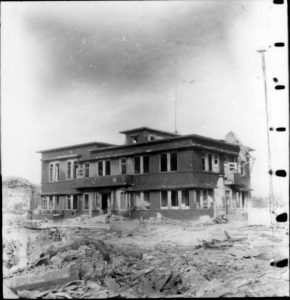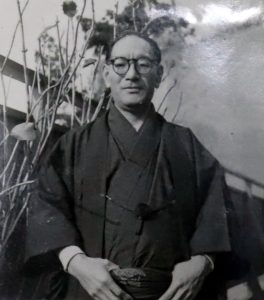Documenting Hiroshima of 1945: Around November, radio broadcasts continue in Hiroshima’s outlying area
Nov. 16, 2024
by Minami Yamashita, Staff Writer
Around November 1945, the building of the Hiroshima Central Broadcasting Bureau (present-day NHK Hiroshima Broadcasting Station), located in Kaminagarekawa-cho (now part of Hiroshima City’s Naka Ward) around one kilometer northeast of the hypocenter, remained nonoperational. The two-story ferroconcrete building had been completely burned out in the atomic bombing of the city. Radio broadcasts continued the day after the bombing from a backup studio located within the Hara Station in the area of Gion-cho (in the city’s present-day Asaminami Ward).
Its predecessor, the Hiroshima Broadcasting Bureau of the Chugoku Branch of the Japan Broadcasting Corporation (NHK), started operations in July 1928 as the sixth such station in Japan. The number of subscribers in Hiroshima Prefecture exceeded around 200,000 by 1944, with the bureau airing nationwide live broadcasts and local programs. In the final stages of the war, however, air-raid warnings accounted for most of the local broadcasts.
Shortly after 8:10 a.m. on August 6, 1945, an announcer who had received the instructions to issue an air raid warning began to read the words, “Chugoku Military District announcement! Three large enemy planes are advancing from Saijo ... .” Just around that time, the A-bomb blast struck the building. Of the 260 staff members, 34 died on that day August 6.
Hiroshi Morikawa, a member of the technical department who experienced the atomic bombing on the stairs of the station building (dying in 1974 at the age of 63), headed for the Hara Station, which had been designated as a meeting place in advance. In a journal entry dated August 6 and titled “Rabbit Droppings,” he wrote about how, using private, inter-station communication lines, “There fortunately was a reply from Okayama. I immediately reported the overall situation and requested a shortwave broadcast from Osaka issuing orders to each station and asking for assistance.”
By the evening of August 6, more than a dozen staff members had gathered at the Hara Station, and the Hiroshima Bureau resumed independent broadcasting at 9 a.m. on August 7, transmitting an official notice from the Hiroshima Prefectural governor. In his journal, Mr. Morikawa wrote about the recovery efforts, such as the relocation of broadcasting equipment and the restoration of lines. On August 29, he wrote, “This evening, we started broadcasting and holding discussions using the main lines. Clear voices were heard over the air for the first time in a while.”
Mr. Morikawa’s oldest son, Takaaki, 85, a resident of Hiroshima’s Nishi Ward, recalled, “My father probably had the spirit of an engineer and the convictions of a broadcaster.” Immediately after the war, Mr. Morikawa wondered whether he should change his profession to farming because of the difficulty in obtaining food. Ultimately, however, he served in various posts, including director of the Yamaguchi Broadcasting Bureau, and continued working in radio until his retirement.
On October 5, Noboricho National School (present-day Noboricho Elementary School), which had lost its school building in the atomic bombing, resumed classes in the burned ruins of the Hiroshima Bureau. The November 7 edition of the Chugoku Shimbun newspaper reported that around 80 students were in attendance at the classes.
(Originally published on November 16, 2024)
Around November 1945, the building of the Hiroshima Central Broadcasting Bureau (present-day NHK Hiroshima Broadcasting Station), located in Kaminagarekawa-cho (now part of Hiroshima City’s Naka Ward) around one kilometer northeast of the hypocenter, remained nonoperational. The two-story ferroconcrete building had been completely burned out in the atomic bombing of the city. Radio broadcasts continued the day after the bombing from a backup studio located within the Hara Station in the area of Gion-cho (in the city’s present-day Asaminami Ward).
Its predecessor, the Hiroshima Broadcasting Bureau of the Chugoku Branch of the Japan Broadcasting Corporation (NHK), started operations in July 1928 as the sixth such station in Japan. The number of subscribers in Hiroshima Prefecture exceeded around 200,000 by 1944, with the bureau airing nationwide live broadcasts and local programs. In the final stages of the war, however, air-raid warnings accounted for most of the local broadcasts.
Shortly after 8:10 a.m. on August 6, 1945, an announcer who had received the instructions to issue an air raid warning began to read the words, “Chugoku Military District announcement! Three large enemy planes are advancing from Saijo ... .” Just around that time, the A-bomb blast struck the building. Of the 260 staff members, 34 died on that day August 6.
Hiroshi Morikawa, a member of the technical department who experienced the atomic bombing on the stairs of the station building (dying in 1974 at the age of 63), headed for the Hara Station, which had been designated as a meeting place in advance. In a journal entry dated August 6 and titled “Rabbit Droppings,” he wrote about how, using private, inter-station communication lines, “There fortunately was a reply from Okayama. I immediately reported the overall situation and requested a shortwave broadcast from Osaka issuing orders to each station and asking for assistance.”
By the evening of August 6, more than a dozen staff members had gathered at the Hara Station, and the Hiroshima Bureau resumed independent broadcasting at 9 a.m. on August 7, transmitting an official notice from the Hiroshima Prefectural governor. In his journal, Mr. Morikawa wrote about the recovery efforts, such as the relocation of broadcasting equipment and the restoration of lines. On August 29, he wrote, “This evening, we started broadcasting and holding discussions using the main lines. Clear voices were heard over the air for the first time in a while.”
Mr. Morikawa’s oldest son, Takaaki, 85, a resident of Hiroshima’s Nishi Ward, recalled, “My father probably had the spirit of an engineer and the convictions of a broadcaster.” Immediately after the war, Mr. Morikawa wondered whether he should change his profession to farming because of the difficulty in obtaining food. Ultimately, however, he served in various posts, including director of the Yamaguchi Broadcasting Bureau, and continued working in radio until his retirement.
On October 5, Noboricho National School (present-day Noboricho Elementary School), which had lost its school building in the atomic bombing, resumed classes in the burned ruins of the Hiroshima Bureau. The November 7 edition of the Chugoku Shimbun newspaper reported that around 80 students were in attendance at the classes.
(Originally published on November 16, 2024)









